Tips for Providing a Defensible Opinion of a Forensic Assessment
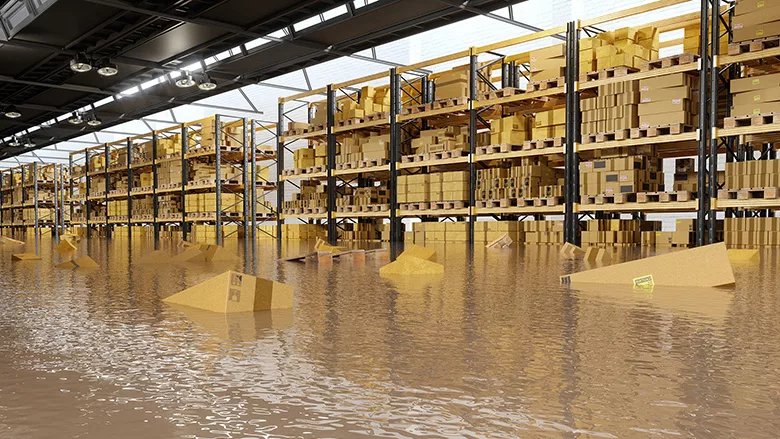
Photo credit: onurdongel/ iStock / Getty Images Plus via Getty Images
When a water loss has occurred in a structure, a variety of professionals can be involved in the steps taken to return the affected area to a pre-loss condition, such as restoration and remediation contractors, indoor environmental professionals (IEP) and forensic experts. It is becoming more common for forensic experts to be involved in the assessment of a water loss or fungal growth in a structure. These experts can be scientists, engineers, architects, contractors, etc. who specialize in determining causation of the moisture source as well as the extent of moisture related damage and/or fungal growth. Multiple parties will rely on these experts’ opinions; therefore, their assessment, methodologies and report of findings are routinely scrutinized by all parties involved. The goal of a forensic assessment is to provide a defensible opinion, and to do that, the opinions should be based upon scientific principles and methodologies, industry standards and best practices.
While forensic assessments can be challenging, there is a simple equation that can be applied to every assessment to increase the defensibility of the approach and ultimately the findings. Detailed Documentation + Diagnostic Testing = Defensibility. If the assessment is detailed and well documented, and hypotheses are tested versus speculated, the confidence level for defensibility increases significantly. This same equation can also be applied to a contractor performing a water restoration project. The contractor’s strategy is commonly exposed to increased scrutiny after their invoice is presented for payment. Detailed documentation of the extent of moisture migration and the drying efforts, as well as pre-determining and documenting the source of the moisture, will not only decrease scrutiny of the strategy employed but also benefit the development of the drying strategy and in turn benefit the client.
Forensic experts are routinely visiting a structure after water restoration, mold remediation or others repairs have been made and will routinely rely on the documentation collected by the contractors to help piece together what happened. The better the initial documentation, the easier and quicker the loss can be resolved for all parties involved. While this article is not intended to make you the foremost expert in causation, the goal is to provide some basic fundamentals from which you can elevate your expertise and value within the industry. As a water restoration contractor, you are commonly one of the first parties to respond to a water loss and have a unique opportunity to determine the cause and document the extent of relatable damage. While not an exhaustive list or in a specific order of importance, fundamentally a forensic assessment of a water loss should include:
- Collection of background information;
- A walkthrough of the area(s) of concern;
- Data collection; and
- Diagnostic testing when possible.
For the purposes of this article, data collection and diagnostic testing are highlighted.
Data Collection
Data collection is one of the most often ignored steps in a forensic assessment and in a drying strategy, which should be considered one of, if not, the most important step to increase the defensibility of the opinion or the strategy employed. Observational data is critical and typically consists of a visual, systematic assessment together with clear photography or video documentation. Clear documentation of active moisture sources, damp conditions (moisture measurements), removed components such as plumbing and the physical damage (staining, swelling, corrosion etc.) or lack thereof, not only increases the confidence in causation but will justify the need for repairs as well as the drying strategy implemented. Poor and limited documentation of a site will only cast doubt on an opinion provided or the necessity of the dry-out strategy employed and the extent to which it was performed.
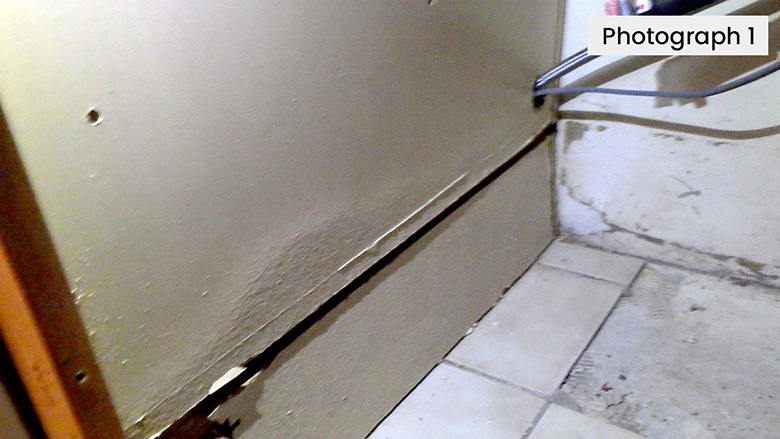
Some useful tips regarding observational data include the use of a flashlight at an angle across a building material, particularly composite wood, to depict modest swelling or disfigurement that may have otherwise went unnoticed (Photograph 1). An angled light is also a great way to evaluate wall surfaces for prior repairs. Wet or damp conditions on a surface can be difficult to see in a photograph. A colored piece of tissue paper provides an excellent method to demonstrate that a surface or material is damp (Photograph 2). Last, a borescope (inspection camera) is an essential tool for anyone assessing a water loss. The small size of the camera head allows the operator to look into walls, beneath cabinetry and through ceilings. The amount of damage and the causes of moisture sources that go overlooked because the person conducting the assessment did not have the tools to look beyond what was in front of them is amazing. Last, photographing moisture measurements is a great way to accurately document that conditions were wet and dry, and eliminate any questions to what you actually encountered. Always remember to have your meters set to the proper substrate and used in the proper manner. Photographic documentation will also highlight any errors you made while documenting the site.
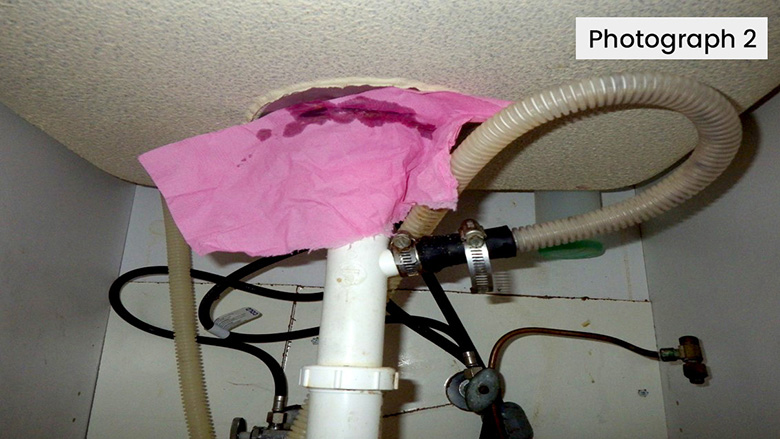
Additional date collection can be in the form of moisture meters, hygrometers, infrared thermometers, manometers, etc. Hygrometers and infrared thermometers are critical when assessing surficial fungal growth related to condensation and elevated relative humidity. Manometers and smokes pens allow documentation of air movement in and out of structure and can help identify pressure differentials. Many of these tools are useful during dry-out as they demonstrate a drying chamber has been created and confirm pressurization of the containment. How does one conduct a moisture assessment and not use a moisture meter? Beyond determining the extent that moisture has migrated, it is useful for scanning and detecting unknown moisture sources and confirming if a moisture source is ongoing or has been corrected. An absence or overall lack of moisture content measurements in drying logs is one of the most commonly scrutinized elements of a dry-out strategy. Daily monitoring and moisture surveys allow for the contractor to defend that their strategy was necessary and the materials were being dried, move equipment as needed and lastly demonstrate the affected areas were dried. It is hard to get paid for the work you completed when you have no documentation to substantiate why the work was performed in the manner that it was.
Diagnostic Testing
For the purposes of the article, diagnostic testing is considered testing that is used to identify the cause of a moisture source. Diagnostic testing can be as simple as turning on plumbing fixtures or water testing a window opening, to as complicated as pressurizing an appliance onsite with a testing rig. If you have the opportunity to test a hypothesis (moisture source) and do not, this will weaken the defensibility of your opinion and even your credibility as an expert. Obviously the expert and contractor should have the knowledge and the comfort level to perform a specific test. When the testing is not in the expert’s wheelhouse, then a more specialized professional can be brought in to help determine the moisture source.
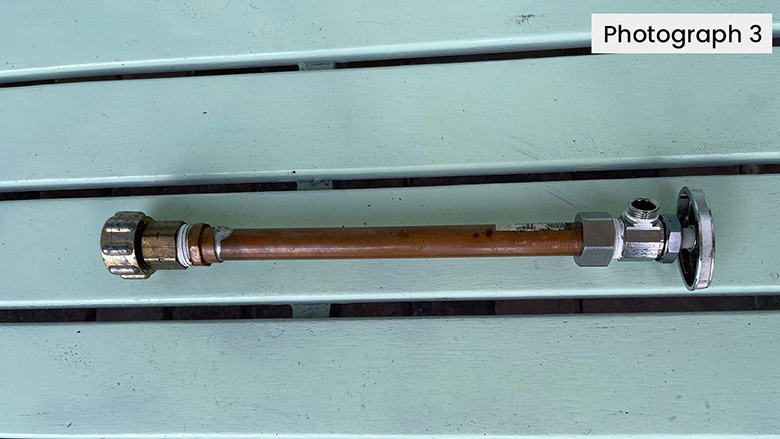
While there are numerous tests and strategies that can be employed during an assessment, the authors want to highlight a few ideas to consider to help strengthen your findings. It is not uncommon to arrive at the site of a water loss and be given a removed plumbing component or an appliance, such as a dishwasher, for assessment. Observational data may lead to a strong opinion, however testing the part can remove all doubt that the part was or was not the source. To accomplish this, you can build a test rig that can pressurize a variety of plumbing components using a hose bib. Photographs 3 and 4 depict a test rig that was used to pressurize a dishwasher on site. Having this ability and foresight will help set you apart in the industry.
Surficial fungal growth is a common problem experienced in the southeast. Property owners return to a condominium unit or single-family home to find fungal growth on the surfaces of walls, ceilings and contents. For most experts and contractors, it’s not hard to determine the cause was elevated relative humidity and dew point temperatures, but often overlooked are the circumstances that led to these conditions. Some basic steps can help you provide a more definitive cause and give your client a starting point to correct the problem. Thermostat set points (temperature), fan settings (on or auto), the size of the air handler and compressor (tonnage), air movement (smoke pen), and collection of air temperature and humidity data inside and outside are useful steps in many of these types of assessments. While this is just the beginning of data that can be collected, it can provide a wealth of information and help guide the client toward the cause of fungal growth which can be difficult to describe to a distraught property owner.
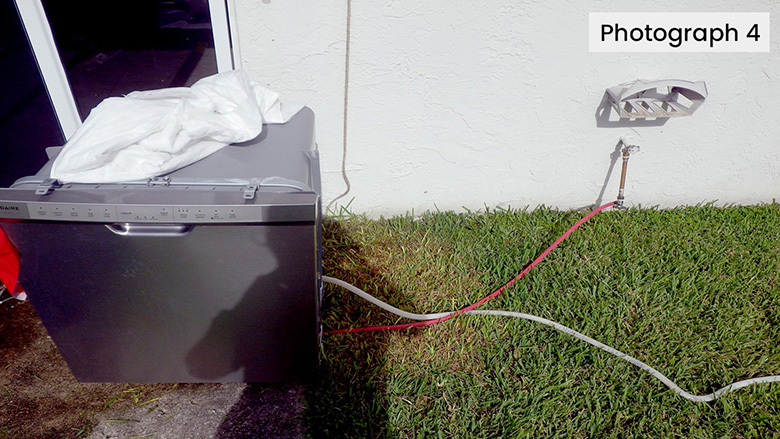
Last, test plumbing and building envelope leaks. This can be as simple as operating fixtures, flushing toilets and running dishwashers through various cycles. While more in depth, the authors routinely perform shower pan tests as they are common sources of water damage in and near bathrooms. Just remember to obtain the water used to fill the shower pan basin from another source as this rules out the shower diverter valve and riser as a source. Don’t be afraid to utilize a garden hose (low-velocity spray) or point source application of water to window openings, vent stacks or other penetrations in the building envelope.
In conclusion, while having the correct answer is important for a forensic expert, it is more important for the expert to demonstrate the steps taken to form that opinion — which is accomplished by collecting data, testing when possible, and relying on sound scientific principles and best practices. These same steps should be used by the restoration contractor strategy to increase the defensibility of the drying strategy employed. It is critical for the contractor to identify and document the source of moisture, collect daily moisture measurements, and provide clear, representative photographs of the affected areas. Clear and detailed documentation is the key to surviving the scrutiny when defending a drying strategy and the necessity for building materials to be removed.
Looking for a reprint of this article?
From high-res PDFs to custom plaques, order your copy today!









